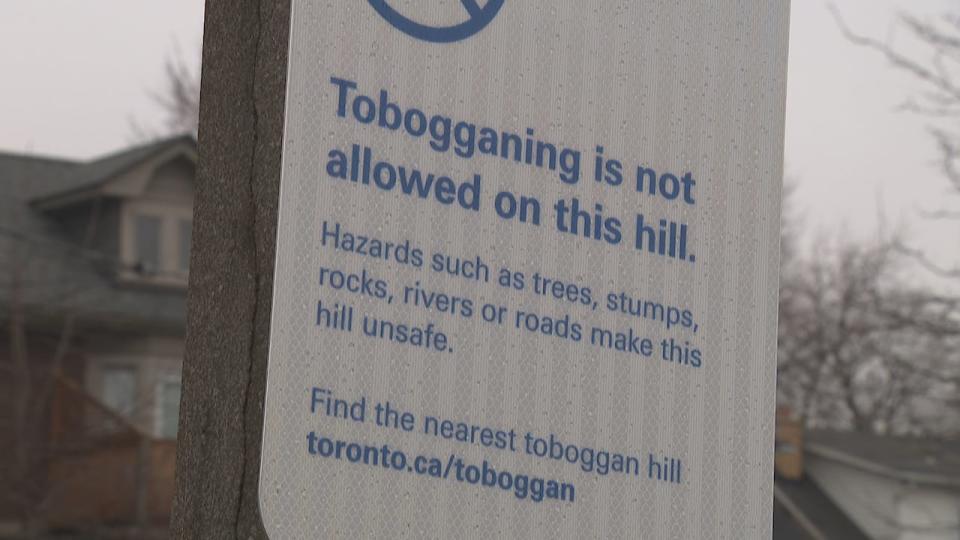A fight over Toronto's ban on tobogganing at 45 hills is headed to city council

A Toronto councillor plans to fight what he's called a "no fun" ban on tobogganing at 45 hills in the city.
Coun. Brad Bradford, who represents Beaches-East York, says he will be moving a motion at a council meeting on Feb. 6 asking the city to reverse the ban, adding Torontonians are tobogganing despite signs telling them not to do so.
"The city can put up a sign and try to stick their head in the snow and pretend that there's not going to be any tobogganing, but you can go out there when we have snow and see dozens of people enjoying the hill like they have for generations," Bradford said.
"It's completely tone deaf to suggest that people aren't going to use the hill as they always have," he added. "We don't want to live in a bubble-wrapped society."
Rather than a ban, Bradford says he wants to see safety measures such as hay bales and street fencing return to the slopes at East Lynn Park, a popular spot for sledding in his ward.
The move comes just weeks after the city banned tobogganing at dozens of hills where it said hazards obstructed slopes. It designated 29 toboggan hills in 27 park locations across Toronto.
Designated toboggan hills must have a clear path from the top of the slope to the bottom, without any obstacles or hazards, such as trees, ditches, trails or fencing, the city said earlier this month. The designated hills are inspected regularly to ensure safety, it added.
Bradford says appropriate signs should be erected at hills across the city to minimize liability to the city in case of injuries, but he declined to say what the signs should say.
"I'll leave that to the lawyers, but they can't say 'No tobogganing.'"
"A tobogganing ban is just ridiculous, and frankly, it's embarrassing. We're developing the reputation of a 'no fun city' and I'll remind folks that it's the same city that tried to ban street hockey, that tried to put cats on leashes," he said. "This was clearly a solution in search of a problem."
Mayor says she hopes to find middle ground in debate
Toronto Mayor Olivia Chow said on Thursday that it might be possible to find middle ground in the tobogganing debate. She said she is working with the city manager to look at options.
"I'll do my best to find a good balance between risk, fun and serious injuries," Chow said. "Let's not have those serious injuries. Let's protect our residents but also allow for children to enjoy themselves."
Bradford has asked Chow to second his motion, saying wants to work in a "collaborative fashion" to reverse the ban.

A sign is seen at one hill saying tobogganing is not allowed. (CBC)
In 2017, the city said it implemented a toboggan hill inspection program. Under the program, city staff regularly inspect "highly-used" toboggan hills and signs are posted that outline the risk of tobogganing.
"The city is responsible for ensuring its properties and any activities performed on its properties are reasonably safe," the city told CBC Toronto in an email on Jan. 12.
Cities mostly protected from lawsuits, lawyer says
Patrick Brown, a personal injury lawyer and a partner at McLeish Orlando Lawyers, says it's difficult for anyone to put responsibility on the city when there is a tobogganing accident.
Municipalities are mostly protected under the law, meaning anyone who tries to take the city to court will face an uphill battle, Brown says. That person would have to prove that the city created the danger and intended to do deliberate harm or knew that the hazard existed, didn't do anything about it and showed reckless disregard, he added.
"Anybody who goes on a city property to toboggan, there's a law that says you willingly assume the risk associated with that," he said.
"The onus, as we would say in the law, is so high on the city that sign or no sign, it's very hard for them to be exposed."


